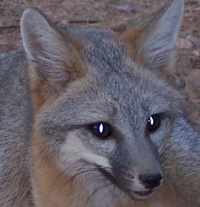
Captured
Gray Fox
Tucson, Arizona
|
Gray Foxes
Gray
foxes have a unique ability not shared with other wild canines: they
can climb trees, using their sharp, stout, slightly curved
claws.
They ascend headfirst and descend the same way.
This
characteristic allows them an escape avenue from coyotes looking to
make a meal out of them or dogs that trail them.
Unfortunately
for the foxes, mountain lions and bobcats, which also
occasionally eat them, can climb even better. The foxes are
silvery-gray from their long snouts to their bushy tails, topped and
tipped with a black streak. Russet fur surrounds
their ears
and edges their white bellies and the bottom of their tails.
Gray
foxes vocalize with hoarse, loud barks that are usually given when
they are upset with intruders in their territories.
A
gray fox averages 32 to 45 inches in length, including its tail, and
weighs an average of 8 pounds. They are found throughout
the eastern half of the United States, the Southwest, and
north
along the Pacific Coast to Oregon. Their preferred habitat
includes brushy, rocky, and forested areas. They
are
usually found on the outskirts of cities and towns rather than within
them like coyotes and bobcats.
Rabies is
a serious
threat to gray fox populations and sporadically reduces them
to
quite low levels. Litters of four pups are born in the spring
and
raised by both parents. High first-year mortality rates means
that it takes years to replicate once
healthy populations.
Luckily
gray foxes are opportunistic foragers and will eat numerous types of
food. They hunt anything from rabbit size on down, including
rodents, birds, lizards, snakes, and insects.
Carrion is
always welcomed. Gray foxes will eat juniper berries,
mesquite
beans, prickly pear fruit, corn, and piñon nuts. They can be
stubborn about possible food sources, often disregarding a
natural wariness of human presence while concentrating on obtaining
something to eat.
Gray foxes that were
overcome with an almost crazed fixation on food have
occasionally bitten predator callers.
These
foxes are usually nocturnal but are sometimes seen out and about in the
morning or evening, flowing over the ground pulling their big
brushy tails behind them.
A special
thanks to Dexter K. Oliver for writing this section. |